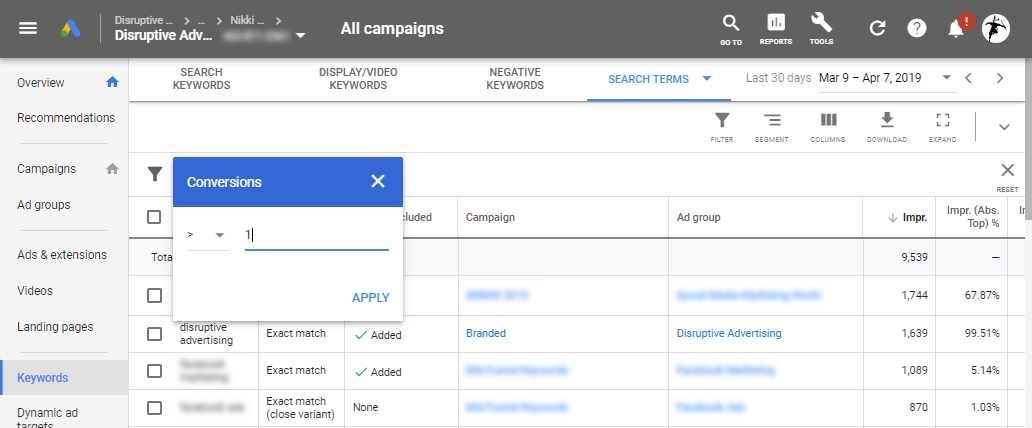How Much Money Are You Wasting on Bad Paid Search Advertising?
by Aden Andrus • January 6, 2020
You know you’re wasting money on bad paid search advertising. Your campaigns might even profitable, but you still know that they could be doing better. Something just feels a little off, a quiet nagging that just won’t go away.
There’s something wrong in your paid search account.
If you’re like most advertisers, you probably can’t even put your finger on the problem. You know your account could be, should be producing better results, but you just can’t figure out what’s wrong!
Bad paid search advertising is a frustrating, but incredibly common problem. It takes a ton of work just to set up a paid search account, let alone optimize it, so if you’ve ever stared at your campaign results and wonder, but why…don’t worry, you’re not alone.
Here at Disruptive Advertising, we get it. We talk to clients in your shoes every single day. Our literal job is to take those head-scratching mysteries, solve them and turn things around.
So, when your sixth sense tells you, something isn’t right, you should listen. Odds are, you’re right. You’re probably wasting a ton of money on bad paid search advertising—even if you can’t figure out how.
Tracking Down the Problem
Fortunately, as elusive as your paid search problems may seem to be, it often isn’t actually all that difficult to track them down…if you know where to look.
For example, when one of our clients came to us, they knew they were burning money on bad paid search advertising. They knew their account could be performing better, they just couldn’t figure out what the problem was.
But, after auditing thousands of paid search accounts, it only took us a matter of minutes to track down a few key problems that were costing them tens of thousands of dollars a month in wasted ad spend.
To help you track down where your paid search account has gone bad, I’m going to walk you through the process we used to reveal this client’s problems. It’s simpler than you might think, and the results were well worth the effort.
The Client
To begin with, let’s start by talking about the client. This particular client was—as you can probably imagine—fairly large and well-established. They were spending about $90,000 a month on paid search advertising and had been managing their accounts in house for several years.
To their credit, their campaigns were actually working. They were driving a fair amount of leads and a reasonable number of sales. But, despite all that, they were barely breaking even on their campaigns.
A few months before they came to us, they bumped up their budget by 30%, hoping that this would fix things and make their campaigns profitable. However, as they eventually discovered, you can’t fix an unprofitable campaign by spending more money.
So, by the time we started looking at the account, they were spending almost $120,000 a month and still not getting great results. They had a problem, they just couldn’t figure out what it was.
Assembling the Data
As we started looking at the account, the first thing we did was choose a date range to evaluate. Simple as this sounds, it’s actually an important key to successfully tracking down the problems in a bad paid search account.
While it’s tempting to try and track down problems by running a blow-by-blow analysis on your account, the best way to see what’s going on in your account is to start by looking at the big picture. On a day-to-day or even week-to-week basis, it’s easy to get lost in the weeds, but if you take a step back and look at the past 3-6 months, it’s a lot easier to spot fundamental problems.
So, with that in mind, we decided to look at the account performance over the past 90-days. That date range was long enough to see broad trends, but also didn’t dip into the time period before their last big adjustment.
Here’s what the data for that time period looked like.
From the table above, it was easy to spot some interesting trends. They were getting about 1 conversion per 500 impressions. That’s not too shabby. Clearly, they were targeting the right audience with the right general message.
The problem, then, had to have something to do with where their budget was going. They were getting a ton of leads, but only 1% of those leads were signing up for their services, so the cost-per-sale was about $2,000—which explained why they weren’t making any money.
For some clients, the question at this point might have been, “What can you do to improve your close rate?”, but this client had a well-established sales team that knew what they were doing. For their market, a 1% close rate was pretty good, so to improve their cost-per-sale, we needed to see if there were any opportunities to decrease their cost-per-lead.
Segmenting the Data
Now that we had the right data, it was time to dive a bit deeper. Since we were looking for ways to reduce their cost-per-lead, we started by looking at how their campaigns were performing in different market segments, starting with their performance across different devices and their Search Terms report.
Device Segmentation
Segmenting your data by device is an easy, often under-utilized way to get insights into your target audience. For example, when we took a look at this client’s account, here’s what we saw:
To this client’s surprise, while the majority of their impressions came from desktop computers, most of their clicks and conversions came from mobile. However, their mobile experience actually wasn’t all that great.
Given this data, there were two clear takeaways: 1) their ads performed better on mobile despite their site’s poor mobile experience and 2) the core problem with their ads didn’t lie in their device performance.
If most of their clicks and conversions had been on desktop, we could have decreased our bids for users on mobile devices. However, the opposite was true, which meant the client probably needed to put more money into mobile (and their mobile experience).
Search Terms Report
Once we knew the problem didn’t lie in their device targeting, it was time to check out the Search Terms report. The Search Terms report is one of our go-to places in our audits. It’s a great place to find answers because it tells you exactly what search queries you’re spending your money on.
Because the Search Terms report shows data on every search term that triggered your ads, it can be a bit intimidating to use. So, to make things simpler, we like to use filters.
To see what percentage of your ad spend is actually going towards search terms that produce conversions, all you have to do is create a filter for “Conversions > 1”.

Scroll down to the bottom of the page and you can quickly see how much of your ad spend went to converting search terms…and what percentage was wasted.
When we ran this analysis for this client, it quickly became clear why their ad campaigns were struggling. In our 90-day date range, they had spent $147,000 on search terms that didn’t convert.
$147,000.
Almost $50,000 a month.
All for nothing.
Is it any wonder that they couldn’t get their campaigns to work? A huge chunk of their budget was being completely wasted! It was like they were asking their paid search account to win an Olympic sprint with both legs tied together.
When we brought this up to the soon-to-be client, it was like watching the lights come on. All of a sudden, everything made sense.
And, to be honest, this is a fairly common experience. After auditing countless paid search accounts, we’ve seen this sort of thing countless times. Sometimes it’s the Search Terms report and sometimes it’s something else entirely, but when you step back, take a look at the big picture and follow the trends, people’s gut instincts are usually right.
More often than not, if you feel like your paid search account isn’t performing the way it should be, you’re probably on to something. It may take some digging, but the truth is out there. You just have to be methodical about chasing it down.
Your turn
Now, if you’ve gotten to the end of this article and you’re thinking, “That’s a cool story, but I don’t have the knowledge or experience to track all of that down on my own”…don’t worry, we’ve got you covered.
If you’d like, we’d be happy to audit your paid search account for free. No charge, no obligation. This is our bread and butter, and whether or not you want to work with us, we want to help you track down the problems in your paid search account.
So, if your sixth sense is telling you that something is wrong, listen! Let us know you’d like a free audit here or in the comments and we’ll get in contact soon. You know there is a problem, why waste more time and money on bad paid search advertising?
What sorts of unexpected things have you discovered in your paid search accounts? Have a horror story to share? Where are some of your favorite places to look for problems? Leave your thoughts in the comments below.







